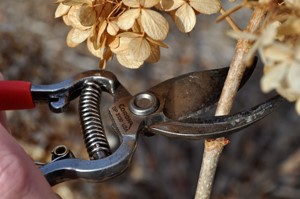Pruning Your Ornamental Shrubs
Sharon Ashworth
Horticulture & Natural Resources Agent
It’s time to prune your shrubs! But before you start cutting it’s important to have a plan. Construct a pruning strategy by considering the types of shrubs in your landscape. Ask yourself two basic questions for each shrub: Is it deciduous or evergreen? Is it a spring-blooming or summer-blooming shrub? Identifying these two basic features of each shrub will determine when and how to prune. If you have a deciduous, spring-blooming shrub wait until after it blooms before you prune. These shrubs produce flowers on last year’s growth so if you prune before they bloom, you will sacrifice this year’s flowers. If you have a deciduous, summer-blooming shrub, prune now. Summer-blooming shrubs produce flowers on this year’s growth. Evergreen shrubs, including junipers, boxwood, holly, mugo pine, and yews are best pruned from now into April.
Next, consider the condition and shape of the shrub. Is the shrub too big for its space? Does it have a lot of dead stems? Is it no longer flowering as profusely as it has in the past? There are three basic methods for pruning shrubs – thinning, heading back, and rejuvenation.
Thinning involves removing select stems by cutting side stems where they attach to a main branch, or completely removing older stems by

cutting them to the ground. Thinning allows greater penetration of sunlight to the center of the plant and improves airflow. Cutting out older stems improves flowering.
Heading back is the selective cutting of terminal parts of a branch. The cut is made to the desired height, just above an existing bud. Heading back is the preferred method of shaping and reducing the height of a shrub. Shearing a deciduous shrub will result in a witch's broom effect (multiple, weak stems). Do not cut into the dead area of an evergreen shrub.
Rejuvenation pruning involves cutting back all the stems on a deciduous shrub down to 3-5-inch stubs. Use this method of pruning when shrubs are too dense and big for more selective pruning techniques. Some shrubs respond well to rejuvenation, including dogwoods, forsythia, lilac, and spirea.
K-State has several different resources to help you decide when and how to prune your ornamental shrubs. I highly recommend taking the time to write down the names of the shrubs in your landscape and when to prune them. Alternatively, you can print out the Guide to Successful Shrub Pruning linked below. This handy resource lists most of the shrubs typically found in the home landscape and indicates, in a table format, when it is best to prune. Following these tips will keep your shrubs healthy and looking great.
Links to resources:
Guide to Successful Shrub Pruning
All About Pruning – A twenty-page publication, for those who want to master pruning this year
Pruning Like a Pro – A K-State Garden Hour video
Pruning Photo Credit: Johnson County Extension
